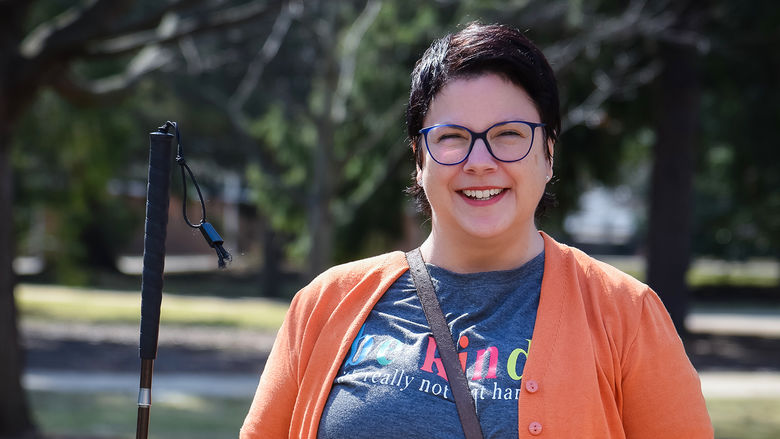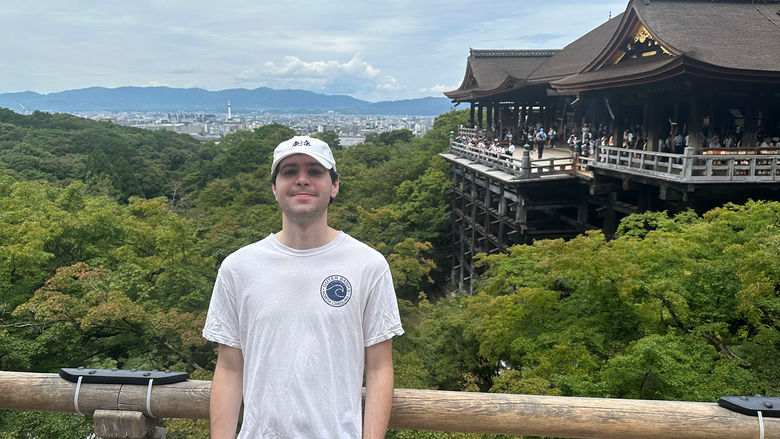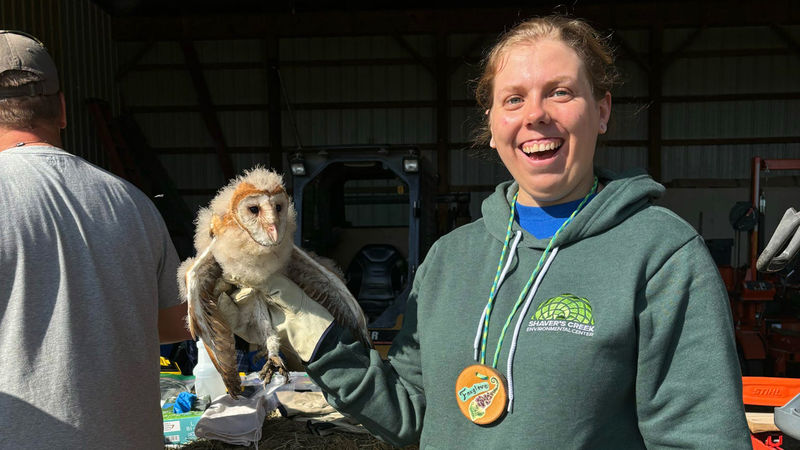

This dialog contains the full navigation menu for this site.

One thing about Haley Hatch is that not having a plan has kind of always been her plan.
It’s not laziness or disorganization. It’s simply how she rolls, and it has been working quite well in her favor.
Hatch didn’t have a plan when she graduated high school in 2016. She took an available job, and after four years, just decided it was time to give college a go. She enrolled at Penn State Altoona in 2020 as a biology major—for no other reason than she liked science as a kid. Turns out, she liked it as an adult, too.
“I loved my professors, and I loved everything we covered in classes. I didn’t really have a goal; I just took things as they came throughout the program. I knew I’d figure it out along the way.”
As graduation drew near, Hatch was unsure of her next steps. She considered several career paths, including genetics and marine biology. However, most of her ideas would involve more schooling, and while she loves learning, money and other resources were also factors. True to form, Hatch decided to just see what was around.
She applied for dozens of different jobs related to biology, not really believing she would get interviews, let alone be offered a position.
“I've never been the type of person to be afraid of going for things. It’s the way I go about my life. Why not try and see what happens?”
What happened was, she did score an interview for a position at Canoe Creek State Park in Blair County. Although she did not score the job, a door opened for her which she eagerly stepped through.
It was during that interview that she learned about something called environmental education. Immediately, her interest was piqued, and she began researching it. The more she found out, the more excited she became about it.
The field teaches how natural environments function and what individuals can do to manage ecosystems and their own behavior to live sustainably. It can take place formally through courses in schools and universities, or informally through workshops, community programs, and in nature centers.
As she was digging through information about the profession, Hatch came across an opportunity at Shaver’s Creek Environmental Center near State College, PA. Paid primarily with professional development and experience, it came with the title of environmental educator, and Hatch thought, what else—"why not?”
The center is run through Penn State Outreach. Seeking to amplify the University’s land-grant mission, Outreach connects communities to Penn State to co-create meaningful impact across the Commonwealth.
Shaver’s Creek provides educational and recreational opportunities for families, schools, the public, and Penn State students. It includes a visitor center, exhibits, an aviary, native wildlife, trails, and a lake. Programs range from outdoor schools and camps to wildlife and flora and fauna exploration, a birding cup, nature journaling, conservation, and research.
Hatch’s eyes practically turned into cartoon hearts.
She was offered the position for the fall semester of 2024. To say she was excited would be a gross understatement.
“Finding that job posting was the greatest thing. I had no idea if I would be hired, and I could hardly believe that I was. It has been life changing.”
Hatch was able to get her hands dirty in just about every part of the center.

Haley Hatch and other counselors celebrate the success at the end of Outdoor School. ODS creates a community for campers and counselors alike.
She was a counselor for Outdoor School, a four-day, residential program for elementary students. The school provides an opportunity for children to learn about the natural world through hands-on lessons and guided exploration.Hatch was responsible for leading groups through activities, creating and teaching curriculum, and mentoring the students.
She also took part in outreach programs for K-12 students both at the center and in classrooms. She led field trips and developed lesson plans for interactive learning focused on science and the environment.
“To be in charge like that was amazing. I got so much experience with leadership development, and it really helped build my confidence.”
Citizen science was another arena Hatch worked in at Shaver’s Creek. This is the practice of public participation and collaboration in research on topics ranging from ecology and conservation to astronomy and information science. Findings are shared with data monitoring and collection programs.
“I really love the idea of citizen science. It was inspiring to be involved. I was happy to experience it for myself, but also to then talk about it with others and get them excited and interested, too.”
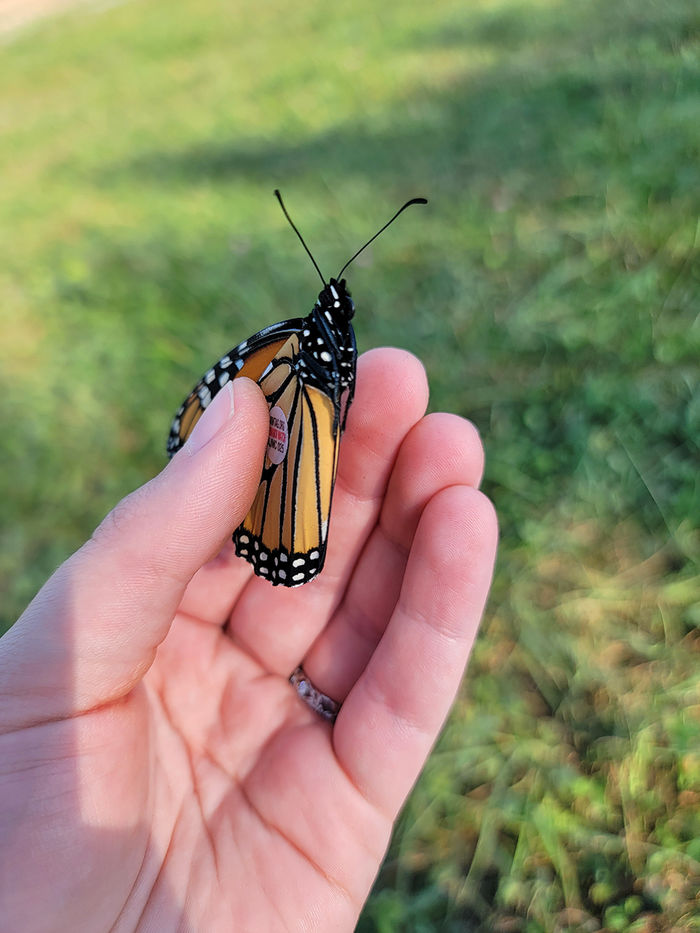
One of the butterflies on which Haley Hatch placed a tag on the "glove" of its wing.
One big project at the center is the Monarch Watch. Each fall, Shaver’s Creek staff and project volunteers scan wildflower patches, meadows, and clover fields for monarch butterflies as they journey to their overwintering grounds in Mexico. Participants capture, tag, (a quick, painless process), then release them.
Tagging helps answer questions about the origins of monarchs that reach Mexico and the timing and pace of migration, among other things.
Hatch says she tagged close to 100 butterflies. “I loved it. It felt magical almost, just frolicking in a meadow and catching butterflies like I was in some Disney movie.”
A second citizens project Hatch assisted in is the Farmland Nestbox Program.
Shaver’s Creek works with private landowners to help promote suitable nesting opportunities for American kestrels and barn owls by installing and maintaining nestboxes. Hatch was able to see the boxes in person and spent time cleaning them out. Further, she had the opportunity to take part in an owl banding program with the Department of Forestry and was able to hold a barn owl.
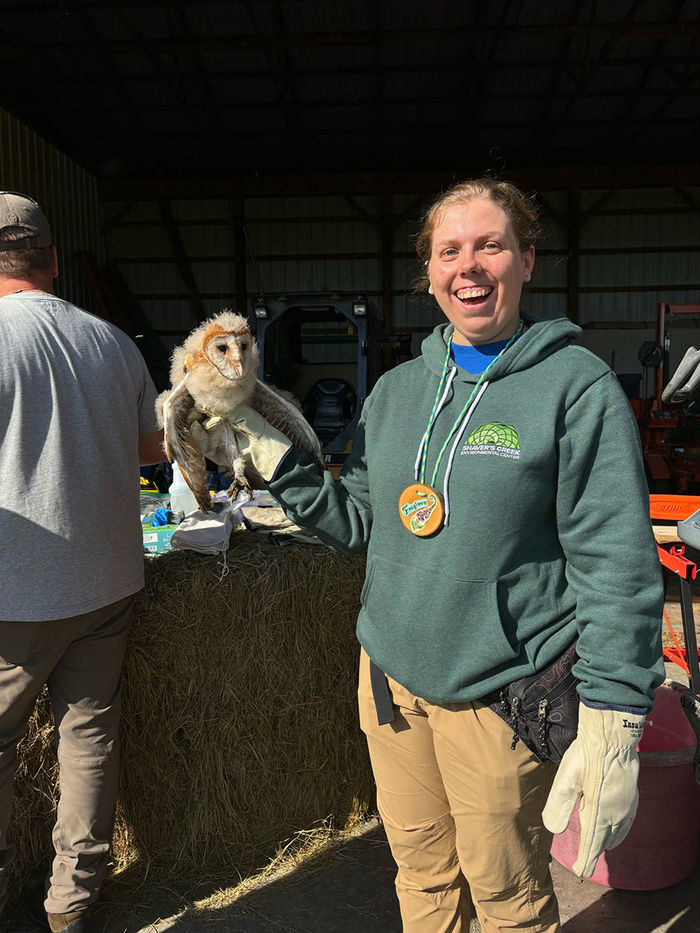
Haley Hatch joined the PA Game Commission in banding young barn owls from a local farm—one of the happiest days of her life.
“It was probably my favorite day of my life, I think. They are just so horrendously ugly that they’re cute. It was pretty amazing getting to hold that little guy.”
Hatch worked with the center’s wildlife programming team and learned some basic husbandry of birds, reptiles, and amphibians, earning wildlife certifications.
She attended the annual conference of the North American Association for Environmental Education in October. “It was a wonderful experience. I met people from all around the world who are doing the things I'm interested in. It was great to see the passion they have for their work.”
Throughout the fall, Hatch collected adventures and skills and really found her home in the outdoors.
“It was all experiential learning, and that’s the best way for me to understand things. I was able to see so many different sides of environmental education, and I just fell in love with each of them.”
As the internship was drawing to a close, Hatch wasn’t overly concerned about her next steps, content to take things as they came, comfortable that an opportunity would present itself.
And when one did, she was already well-prepared for it.
It’s occasionally possible for interns to work multiple seasons at Shaver’s Creek. Hopeful she would be considered to do so, Hatch had already applied for the spring. She was thrilled when she was offered the job.
Comfortable in the workings of the center and confident in the skills she acquired during the fall, Hatch hit the ground running.
There was another round of outdoor school and another session of school outreach to prepare for and run. There were public programs to lead and trail stewardship to do. It was kestrel banding season, and there were more wildlife trainings.

After much training, Haley Hatch was finally trusted to work with Tea, a broad-winged hawk.
But the biggest spring event is the Maple Harvest Festival, held annually at the end of March. The festival has been a staple for Shaver’s Creek since 1984. It’s a way for visitors to learn about the maple sugaring process from colonial times to present day.
Hatch helped tap 26 trees and collect the sap. As part of the production team, she also helped boil it down into maple syrup at the facility’s Sugar Shack. The team was able to make about one gallon of syrup from the sap they collected. Hatch then helped can the finished product. During the festival, Hatch was stationed at the Shack. She explained the history and evolution of maple sugaring and how to identify maple trees and collect sap. She also demonstrated how sap is made into syrup.
“When you are in or near the Shack, you can see and feel the fire, you hear the sap boiling, and you can smell the syrup being made. It's such an experience, and I was so excited to share it with people who didn’t know anything about it.”

The last leg of maple syrup production at Shaver’s Creek.
And then, after a frenzied pace of work and a flurry of activity, it was all done. What had been her life for nine months was over. She was heartbroken but heartened. Her work at the center ignited a passion for the natural world. It showed her the many things she can do with a career in environmental education and how they can even be combined. It gave her the skills necessary to carry out the work.
There are empty spaces where other employees, animals, the grounds and facilities, and children were, but Hatch is fulfilled by all she learned and accomplished at Shaver’s Creek. She feels fulfilled by the ways she’s grown personally and professionally.

Haley Hatch trains for a stream study, conducted with students to introduce the relationship between bioindicators and water quality.
She’s taking it all with her into the next phase.
It’s probably not a big surprise at this point to learn that Hatch doesn’t exactly have a solid plan.
She has family in Canada and is thinking about immigrating there. While awaiting a work visa, she’d like to explore the country, specifically Quebec. She wants to explore more nature and more of the natural world.
“The idea of change is thrilling. I just want to travel. I want to experience, I want new.”
A wanderer’s spirit, an adventurer’s soul, Hatch will always be ready for the next opportunity.
